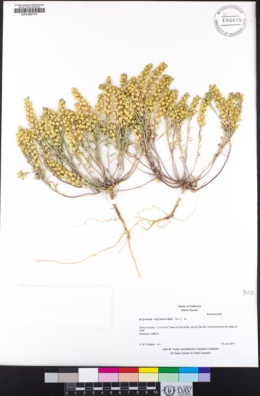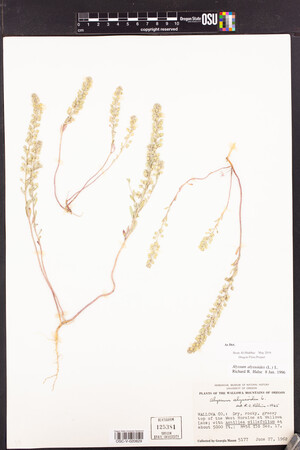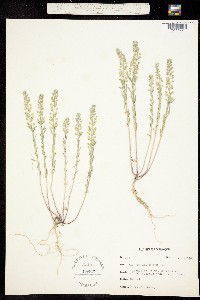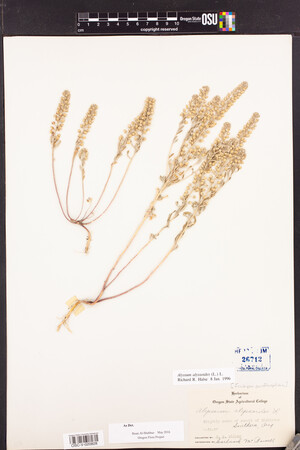Alyssum alyssoides
|
|
|
|
Family: Brassicaceae
Pale Madwort
[Alyssum calycinum L., moreAlyssum campestre (L.) L., Calepina alyssoides L., Clypeola alyssoides L.] |
Annuals; canescent throughout, trichomes appressed, 6-10- rayed, mixed with simple and forked on pedicels and sepals. Stems simple or few to several from base, erect, ascending, or decumbent, (unbranched or branched distally), 0.5-3.5 (-5) dm. Cauline leaves subsessile or (proximal) shortly petiolate; blade usually narrowly oblanceolate to linear, sometimes spatulate or obovate, 3-4(-4.5) cm × (0.5-) 1-3.5(-5) mm, base attenuate or cuneate, apex obtuse or acute. Fruiting pedicels divaricate or ascending, straight, slender, 2-5(-6) mm, trichomes stellate, with fewer, simple and forked ones. Flowers: sepals (persistent) oblong, (1.5-)2-3 × 0.7-1.1 mm, pubescent as pedicels; petals (often persistent) white or pale yellow, usually linear to linear-oblanceolate, rarely obovate, 2-3(-4) × 0.3-0.7(-1) mm, apex emarginate, glabrous or sparsely stellate-pubescent abaxially; filaments (slender) not appendaged, toothed, or winged, 1-1.5 mm; anthers ovate, 0.15-0.2 mm. Fruits orbicular, (2-)3-4(-5) mm diam., apex emarginate or truncate; valves uniformly inflated at middle, strongly flattened at margins, sparsely stellate-pubescent; ovules 2 per ovary; style (slender), 0.3-0.6(-1) mm, basally stellate-pubescent or glabrous. Seeds oblong to ovoid, compressed, 1.1-2 × 0.7-1.1 mm, margins narrow, ca. 0.1 mm wide. 2n = 32. Flowering May-Jul. Roadsides, railways, waste grounds, disturbed sites, grassy areas, fields, sagebrush flats, limestone ledges or bluffs; 0-1800 m; introduced; Alta., B.C., Man., Nfld. and Labr. (Nfld.), Ont., Que., Sask.; Alaska, Ariz., Calif., Colo., Conn., Idaho, Ill., Ind., Iowa, Kans., Maine, Md., Mass., Mich., Mont., N.J., N.Mex., N.Y., Ohio, Oreg., Pa., R.I., S.Dak., Utah, Vt., Va., Wash., W.Va., Wis., Wyo.; Europe; sw Asia; n Africa. Annual herb 5 - 30 cm tall Stem: covered with star-shaped hairs. Leaves: alternate, short-stalked, 6 - 15 mm long, reverse lance-shaped with the leafstalk at the narrower end, base tapering, tip blunt, covered with star-shaped hairs. Flowers: in elongated clusters, without bracts at bases, pale yellow or white, 3 - 4 mm long. Petals four, narrowly oblong. Stamens six. Fruit: a pod, stalked, widely divergent, 3 - 4 mm long, nearly as wide, spherical, flattened at the margin, convex toward the center, and hairy. With four seeds, two per chamber. Similar species: No information at this time. Flowering: May to mid-June Habitat and ecology: Introduced from Europe. In the Chicago Region, Alyssum alyssoides has naturalized into woods and waste places, often in sandy areas. It also occurs as an infrequent railroad weed. The authors of Plants of the Chicago Region have watched A. alyssoides spread from a few plants at a campground in Newton County, Illinois to countless thousands throughout the grounds. Occurence in the Chicago region: non-native Etymology: Alyssum comes from the Greek words a, meaning not or against, and lyssa, meaning rage or madness. The plant was once thought to cure madness and rabies. Alyssoides means "resembling the Alyssum genus." Author: The Morton Arboretum Annual, 5-25 cm, stellate-hairy throughout; lvs oblanceolate, 6-15 mm, entire, obtuse; fls pale yellow or nearly white, 2 mm wide; pet narrowly oblong; frs on widely divergent pedicels, orbicular, 3-4 mm, flat at the margin, convex toward the center; seeds 2 per locule; 2n=32. Native of Europe, abundant as a weed in waste places nearly throughout our range, and to w. U.S. May, June. (Clypeola a.) Gleason, Henry A. & Cronquist, Arthur J. 1991. Manual of vascular plants of northeastern United States and adjacent Canada. lxxv + 910 pp. ©The New York Botanical Garden. All rights reserved. Used by permission. Indiana Coefficient of Conservatism: C = null, non-native Wetland Indicator Status: n/a From Flora of Indiana (1940) by Charles C. Deam A plant of sandy waste places and fallow fields. My Benton County collection is from railroad ballast where it was abundant. ...... Diagnostic Traits: Annual with stellate pubescence; leaves spatulate; sepals persistent; flowers yellow or white; fruits globose, 4-seeded. |





















































































